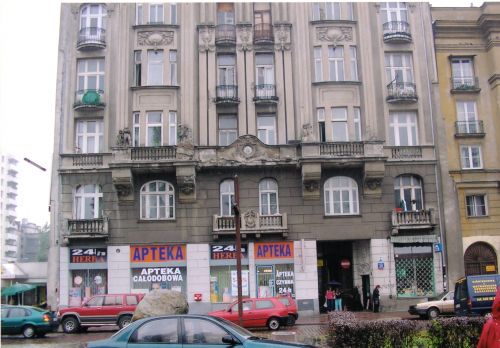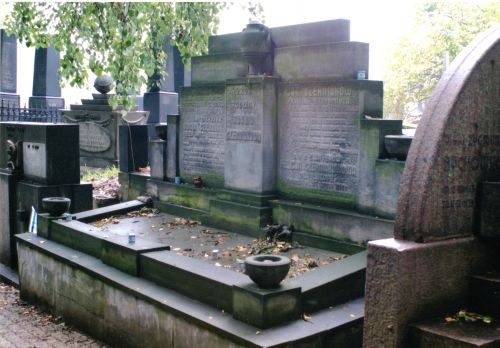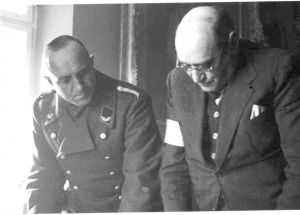Adam Czerniakow
Adam Czerniakow with German official
Adam Czerniakow was born during 1880 in Warsaw to a middle-class assimilated family. He completed his chemical engineering studies in 1908 at the Warsaw Polytechnic, he went on to study industrial engineering in Dresden. Later he taught at the Jewish community’s vocational school in Warsaw and served in various posts in independent Poland. For many years Czerniakow represented Jewish artisans in several Polish organisations. From 1927 to 1934 he was a member of the Warsaw Municipal Council, and in 1931 he was elected to the Polish Senate. Before the Second World War, he was a member of the executive council of the Jewish community. But in his public career between the wars Czerniakow was not regarded as a leader by the Jews, since he was not a member of any political party and had trouble expressing himself in Yiddish.
During the first week of the Second World War, Maurycy Mayzel, chairman of the Jewish community’s council, was one of the many who fled Warsaw. On 23 September 1939, in the midst of the siege of the city, Czerniakow noted in his diary that Stefan Starzynski, the mayor and commissar for civil defense, had appointed Czerniakow ‘ head of the Jewish religious community in Warsaw.’ On 4 October, a few days after the city’s surrender and the beginning of the German occupation, Czerniakow wrote: “I was taken to Szucha Avenue, where I was ordered to add twenty-four people to the community council and to serve as its head.” The official titles used by Czerniakow until the middle of 1941 were Head of the Judenrat and President of the Jewish Religious Community of Warsaw. From the middle of May 1941, his functions and authority were defined in the ghetto as corresponding to those of the mayor in the Polish part of the city.
The first Judenrat, established in October 1939, consisted of twenty-four members, including persons of recognised stature within Jewish society and outstanding figures in political organisations. Among them were the Zionist leader Maximilian Hartglas; Samuel Zygelbojm, a leader of the Bund; Isaac Meir Levin, the outstanding figure in Agudat Israel and Abraham Weiss, a leading member of Mizrahi. Most of the party activists included in the first Judenrat left Warsaw and travelled abroad during the first month of the occupation, when it was still possible to leave. Czerniakow too had this opportunity, but he refused to leave and sharply criticised the leaders who fled the city, claiming they would secure aid in the free world for the masses suffering under the Nazis brutal regime of terror. However, even after a number of the Judenrat members had left, there still remained in it persons with wide experience in public service, among them Abraham Gepner; Joseph Jaszunski, the director of ORT in Poland; and Stanislaw Szereszewski, the chairman of TOPOROL, an association that promoted agriculture.
The Jewish community in Warsaw during the interwar period had provided for religious and educational needs and for relief work for the poor and needy. After the ghetto was established, In October 1940, the scope of the Judenrat’s activities increased considerably, and it had to deal with matters of food, work, health, housing, sanitation, and policing – functions normally carried out by the municipality and the state authorities. The structure and bureaucracy of the Judenrat also broadened considerably. At one point during the ghetto period it had twenty-five different departments and some 6,000 workers, as compared to 530 in the pre-war Jewish community. Some of the Judenrat officials, particularly in the higher administration and the Jewish Order Service, included agents planted by the German Security Service and opportunists prepared to collaborate at any price. Czerniakow despised these people, but he realised that they were a necessary evil. Groups arose in the ghetto that for various reasons tried to oust Czerniakow and some of them, like the one led by Abraham Gancwajch, had the support of members of the German police and the Security Services, the SD (Sicherheitsdienst). All these attempts failed since Czerniakow was supported by the civil authorities in the Generalgouvernement.
The Jewish Underground severely criticised Adam Czerniakow and the Judenrat’s policy. During the ghetto’s existence, public control committees were set up to strengthen supervision of the Judenrat and to improve the effectiveness of its personnel, but they brought no real results. In studies of the Warsaw ghetto, much attention has been devoted to evaluating Czerniakow’s activities. An analysis of this material shows that Czerniakow endeavoured to prevent the direct intervention of the German authorities, and sought to organise the internal affairs of the Jews with a minimum of outside involvement. This approach made possible clandestine economic activity, the illegal smuggling of food, and so on. At the same time, there is no proof that Czerniakow maintained contact with the Jewish Underground, or sided with secret political activities. On the other hand, he persistently promoted education for the children of the ghetto, and strove to save Jews in danger of being executed, for crimes both real and imagined.
During the years of Adam Czerniakow’s tenure as the head of the Warsaw Judenrat, he came into daily contact with the German police, and the civil authorities, who changed five times until the mass deportation during the summer of 1942. In particular from May 1941 onward, Czerniakow maintained constant contact with Max Bischoff, the German official in charge of the Transferstelle., This body regulated the movement of merchandise into and out of the ghetto. Until the ghetto was established, Czerniakow was permitted to maintain contact with the Polish authorities in the Warsaw municipality, chiefly the Polish mayor, Julian Kulski. In his contacts with the Germans, Czerniakow sought ways to influence them and arouse some sort of sensitivity to and consideration for the ghetto situation. These attempts were of no avail. He was twice beaten up by the Germans and suffered many insults. Adam Czerniakow gained a certain measure of understanding through his dealings with the ghetto commissar, Heinz Auerswald, but Auerswald too misled Czerniakow during the fateful period leading up to the mass deportations from the Warsaw ghetto to the Treblinka death camp during the early summer of 1942.

Czerniakow's Residence on Chlodna Street Warsaw - Sept 2005 (Chris Webb Private Archives)
Chroniclers and diarists of the Warsaw ghetto are divided as to Czerniakow’s personality and characteristics. Some such as Emanuel Ringelblum and Itzhak Katzenelson, both with a public background and close to the Jewish Underground, were severely critical, seeing in Czerniakow an assimilator who mixed with assimilators, a man lacking close contact with the Jewish masses, who tended toward self-esteem and absurd public ceremonies in the midst of the grim reality of the ghetto. However, people who worked with Czerniakow praised the man and his qualities. He did indeed place assimilators in key positions, as when he made Jozef Szerynski, a police officer who had converted to Christianity, commander of the Jewish Order Service, a choice considered miserable by all. But the accusation of a tendency toward self-aggrandizement and hollow ceremony is unfounded. It is generally accepted that Czerniakow had great personal decency and good intentions. A member of the Jewish Underground and a leader of the ghetto fighters, Mordechai Tenenbaum, noted in his diary that there were only three truly honest persons among the heads of the Judenrat, one of them being Czerniakow. Unlike the Judenrat leaders Mordechai Chaim Rumkowski and Jacob Gens, Adam Czerniakow was not at all guided by personal ambition, and was willing to co-operate with the Nazis, only up to a point.
Refusing to help in the mass deportation of the Jews of Warsaw which commenced on 22 July 1942, within the framework of Aktion Reinhardt, which was organised by Hermann Höfle from Lublin, Adam Czerniakow took his own life at 4.00 p.m. on 23 July 1942, after he had discussed with Hermann Worthoff, a member of Höfle's staff, the number of days, the Aktion would be carried out - i.e. 7 days a week. According to one version, a note was found on his desk, addressed to his wife Felicja (Niunia) saying, 'They are demanding that I kill the children of my people, with my own hands. There is nothing for me to do but to die.' His death was interpreted as the protest of a man who was not prepared to 'cross the line' between conducting ghetto activities and handing over Jews.
Adam Czerniakow was married to Felicja, more commonly known as Niunia and they had one child, a son named Jas, who fled to Lvov, and he probably perished there. In the mid-1960’s, Yad Vashem received Adam Czerniakow’s wartime diary, which he kept regularly from 6 September 1939 until the day of his death on 23 July 1942. It consists of eight notebooks with 1,009 small pages in chronological order. The fifth notebook, covering the period between 14 December 1940 and 22 April 1941, has been lost. Czerniakow’s diary, which has been published in Hebrew, English, German and Polish, is one of the most important surviving documents from this dark period, and is a fascinating account of daily life within the Warsaw ghetto. It casts light on the man who stood at the head of the Warsaw Judenrat, provides a wealth of information about people and events and the brutal nature of the German rule of terror over the Jewish people.

Czerniakow's Grave - Jewish Cemetery Warsaw - September 2005 - Chris Webb Private Archive)
Sources:
Encyclopaedia of The Holocaust – published by Macmillan Publishing Company New York 1990
Sir Martin Gilbert, The Holocaust, Collins London 1986
Wiener Library, London, UK
Photographs – Yad Vashem and Chris Webb Private Archives
Thanks to Lukasz Biedka and Cameron Munro
© Holocaust Historical Society 2019


